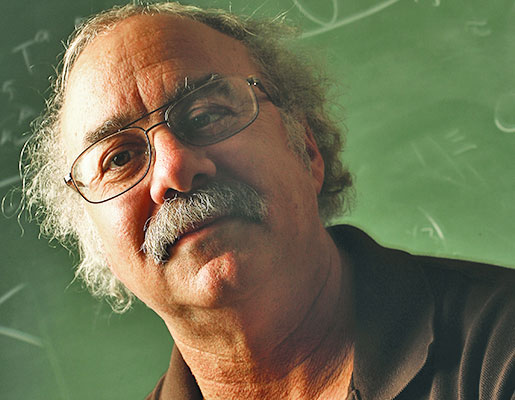A nightmare scenario
The Higgs boson looks exactly as Marc Sher described it. Dang!
It turns out that the Higgs boson looks exactly like Marc Sher always said it would, and now he’s a little bummed.
Sher, professor of physics at William & Mary, has devoted his entire professional life to theoretical description of the Higgs. Announcements this week refined and cemented a July 4, 2012 report that the European collaboration at CERN had found the Higgs. The Higgs boson is a subatomic particle, first postulated in the 1960s as a link between energy and matter.
Analysis of data from experiments at CERN’s Large Hadron Collider resulted in a “5 sigma” announcement of Higgs discovery in July. Sher explained that the recent reports verified the anticipated spin and parity of the Higgs and laid to rest concerns about some of the July data related to decay of the particle.
If it only didn’t fit the Standard Model so well…
Physicists are happy that the Higgs results fits with the Standard Model, the physicists’ inventory of the particles and forces from which the universe is assembled. For Sher, the results are the vindication of a career and verification of a great deal of work. Despite all that, he maintains that the much-anticipated Higgs results add up to a nightmare scenario.
“I always said that the nightmare scenario would be if they found the Higgs and nothing else,” he said on Thursday. “That’s what they found—the Higgs and nothing else .”
He explained the CERN experimenters have proved existence of a conceptually nice and neat all-wrapped-up Higgs boson. All well and good, but Sher was hoping that anomalies or oddities that arose along with the Higgs discovery would have represented entry points for new physics.
“Then it would mean that there’s something we could learn, something we don’t understand. But when it’s exactly what you expect, you don’t learn much,” he said.
A regular cat, not Schrödinger’s cat
“Now, we’re like the cat who has stalked a mouse for 35 years,” he continued. “We finally catch the mouse…and now we’re wondering what to do with it.”
Just as he was following the July 4 announcement, Sher is being sought by media for context, explanation and commentary on the Higgs. An interview with NPR’s Richard Harris was featured on All Things Considered on March 14, the same day of the announcement and, coincidentally, the birth date of Albert Einstein.
Even though the Higgs data offered no apparent points of entry for new physics, Sher says there’s plenty to keep a theoretical physicist busy.
The next big thing for theoretical physicists
“There’s neutrinos. There’s supersymmetry. There’s dark matter—that’s the next big thing, I think,” he said. “I’m writing a paper now on the possibility that there's another Higgs that they had missed at CERN. It’s lighter and decays into what we call dark photons. There’s certain things they could look at over at CERN that would help them find these, But odds are they’re not there.”
CERN is dark now, shut down for refitting and for preparations for the next round of experiments, slated to begin in 2015. Sher begins his post-Higgs career by preparing a talk. The final slide on his PowerPoint sums up his take on the Higgs experiment results.
The slide shows “The Scream,” by Edvard Munch. ![]()
















